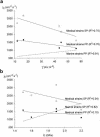Bacterial strains isolated from different niches can exhibit different patterns of adhesion to substrata
- PMID: 15184186
- PMCID: PMC427793
- DOI: 10.1128/AEM.70.6.3758-3760.2004
Bacterial strains isolated from different niches can exhibit different patterns of adhesion to substrata
Abstract
Various mechanisms have been demonstrated to be operative in bacterial adhesion to surfaces, but whether bacterial adhesion to surfaces can ever be captured in one generally valid mechanism is open to question. Although many papers in the literature make an attempt to generalize their conclusions, the majority of studies of bacterial adhesion comprise only two or fewer strains. Here we demonstrate that three strains isolated from a medical environment have a decreasing affinity for substrata with increasing surface free energy, whereas three strains from a marine environment have an increasing affinity for substrata with increasing surface free energy. Furthermore, adhesion of the marine strains related positively with substratum elasticity, but such a relation was absent in the strains from the medical environment. This study makes it clear that strains isolated from a given niche, whether medical or marine, utilize different mechanisms in adherence, which hampers the development of a generalized theory for bacterial adhesion to surfaces.
Figures

References
-
- Bakker, D. P., F. M. Huijs, J. de Vries, J. W. Klijnstra, H. J. Busscher, and H. C. van der Mei. 2003. Bacterial deposition to fluoridated and non-fluoridated polyurethane coatings with different elasticity and surface free energy in a parallel plate and a stagnation point flow chamber. Colloids Surf. B 32:179-190.
-
- Bos, R., H. C. van der Mei, and H. J. Busscher. 1999. Physico-chemistry of initial microbial adhesive interactions—its mechanisms and methods for study. FEMS Microbiol. Rev. 23:179-230. - PubMed
-
- Camesano, T. A., and B. E. Logan. 2000. Probing bacterial electrosteric interactions using atomic force microscopy. Environ. Sci. Technol. 34:3354-3362.
-
- Dalton, H. M., and P. E. March. 1998. Molecular genetics of bacterial attachment and biofouling. Curr. Opin. Biotechnol. 9:252-255. - PubMed
Publication types
MeSH terms
LinkOut - more resources
Full Text Sources
Molecular Biology Databases

